Drawing Three Dimensional Forms |
||||||||||||||||
|
Page 02 / 08
Art Book with chapters on Charcoal, Pencil and Brush DrawingTHE CYLINDERThe light and the shadow. — Half the curved surface of the cylinder (Fig. 5) is light and half is shadow, one base is light and the other is shadow, and two opposite elements of the cylinder separate the light part of the curved surface from the shadow. The high light. —If the cylinder is polished and both the light and shadow of its curved surface are seen, the light, if sunlight, will strike upon the curved surface along some one element so as to be reflected directly to the eye, and thus give, instead of a glitter point, a glitter line or element[1].' If the light is that of a studio, it will be reflected to the eye from a number of elements, and thus give a band of light parallel to the axis of the cylinder. The width of this band of glitter light depends upon the width of the window. From this high light the curved surface curves in each direction so that the farther it is from the high light, the farther from the eye it reflects the light which it receives ; and finally we reach the shadow elements, which separate the light from the shadow. The rays of sunlight are tangent to the surface in these elements which, receiving no direct light, appear very dark ; toward the high light from these elements we have with sunlight a broad and simple mass of light, marked by the glitter elements and by the half light which gives the gradation into the shadow and which is most marked near the shadow elements. 1. As we have two eyes, there are really two glitter points upon the sphere and two glitter elements upon the cylinder and cone, but they are near each other.
Gradation in the shadow. — The shadow element receives no direct light, and generally it receives less reflected light than the other elements in the shadow, so that the shadow is generally darkest at the shadow elements. The contour element on the shadow side is generally decidedly lighter than the shadow element, and between these elements the shadow is generally affected by reflected lights so that its lightest part is between the contour and the shadow element. The cast shadow. — In Fig. 5 the cast shadow is darker upon the vertical than upon the horizontal surface, although it may be the other way when the light comes from another direction. Though not shown by the photograph, a small part of the cast shadow nearest the cylinder was the darkest part of the cast shadow. The contour of the cast shadow is composed of straight lines, which are the shadows of the two shadow elements of the cylinder, and of a curve which is the shadow of half the circular edge of the upper base. Shadows soften as they recede from the object. — The softening of the shadow, as it recedes from the object which casts it, is due in all the figures to the fact that the light comes from a window several feet in width. From each side of this window the rays pass tangent to the object so that they cross each other and produce a series of shadows overlapping each other, and which increase gradually the strength of the shadow until its full depth is found beyond the boundary of the surface from which the cylinder cuts off part but not all the rays which enter the window. Near the object this partial or soft shadow covers very little space, and at the object practically none, so that the cast shadow where it begins is very keen and becomes softer as it recedes, until often with a studio light it may not express the form of the object that causes it. THE CONE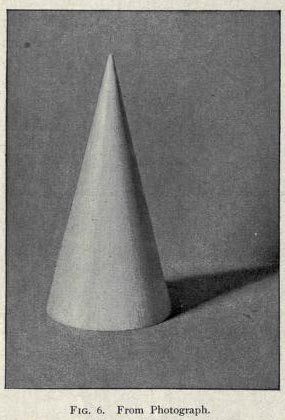
The light and the shadow. —When the cone is directed toward the light, all its curved surface is light and the base is shadow ; when directed from the light, the base is light and the curved surface is wholly shadow. The curved surface may be both light and shadow in any proportion. The light and shadow are separated by elements ; but though they may be opposite elements, as in the cylinder, the proportion of light to shadow would seldom be the same. The high light and the light. — When the curved surface of the cone (Fig. 6) is partially or wholly in light, one element will reflect the light directly to the eye and be the glitter or high light.. From this high light the curved - surface extends in both directions towards the shadow elements, which reflect no direct light to the eye and which are the darkest elements. The nearer any element in the light is to the shadow element, the farther from the eye it reflects the light, and so, as in the case of the cylinder, there is a perfect gradation of tone from the high light to the deep shadow of the shadow elements. The change is gradual and most marked near the shadow elements in the half lights, so that as we go from the shadow elements toward the glitter element the effect is that of a mass of light. The shadow. — The shadow element generally reflects to the eye less reflected light than the other elements in the shadow, and the darkest shadow upon the cone is generally at the shadow element. From the shadow element toward the contour element on the shadow side there is gradation due to the reflected light, which is strongest between the contour and shadow elements. The contour element is usually lighter than the shadow element. The cast shadow. — The cast shadow in Fig. 6 is bounded by straight lines which are the shadows of the shadow elements, and, as in the other figures, it is sharpest and darkest nearest the cone. Effects are accented at the vertex. — The light and dark are concentrated at the vertex of the cone and pyramid and are thus accented, so that the shadow on the cone is darkest and the light lightest nearest the vertex. Gradation in all parts. — Fig. 6 does not perfectly illustrate the effect, which should be that of a gradually increasing tone from the glitter element to the shadow element, and the same in the other direction, so that the tone at the contour element at the left should be darker than that upon any element between the contour and glitter elements. THE PYRAMIDA square pyramid is represented in Fig. 14 with other objects, but will serve to illustrate the remarks upon solids of this type. The light and the shadow. — If the apex is directed toward the light, all the lateral faces will be light and the base shadow ; if the apex is directed from the light, all the lateral faces will be shadow and the base will be light. Generally some of the faces are in light and others in shadow, and there is gradation and variation in all. The lightest face. — The lightest face is that which reflects the light most directly toward the eye, and it is lightest nearest the eye where it contrasts with the adjoining face. The darkest face. — The darkest face is the one which sends the least light to the eye ; it appears darkest along the lateral edge which is nearest the eye, and which separates it from the adjoining lighter face. Gradation due to perspective and to contrast. —'These effects are due to the fact that a dark surface appears lighter as it recedes, and a light surface appears darker, and also to the fact that contrasts of light and dark, or of any two different tones, increase their difference where they juxtapose by causing the dark to appear darker and the light to appear lighter. Slight differences in value to be represented. — In Fig. 14 the base and the light lateral face appear to have the same value. In nature the base was slightly darker than the face ; this difference should be expressed in any light and shade drawing after the effect of the masses which the illustration gives has been represented. OBJECTS OF DIFFERENT COLORS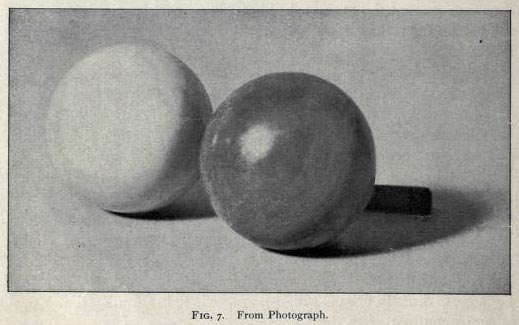
A colored object has light and shadow upon it. — The solids represented have all been of uniform white color, and the different lights and darks have been due solely to the effect of light and shade. Fig. 7 represents two spheres, one white and the other red, and illustrates the fact that there is light and shade upon a dark object just as there is upon a white one. The difference between the light and dark is not as great upon the red sphere as upon the white, but there is the contrast of the same masses of light and dark, and in each mass there are the same gradations as in the corresponding mass upon the white sphere. The red sphere, however, appears lighter at the left part of its contour than nearer the high light. This is due to the fact that the sphere was highly polished, and reflected so much light from the surrounding objects that the effect of the principal light from the window was destroyed by the strong reflections. The shadows differ in values. — A piece of charcoal is' seen in the shadow of the red sphere. It appears much darker than the sphere, and illustrates the fact which students always fail to realize, — that color always shows through the shadows so that the shadows upon objects of different colors and luminosity are always of different values. Cast shadows reflect dark. —.The cast shadows are much sharper and darker near the spheres than farther away, and they reflect upon the spheres so as to darken the parts near the contours. The high light prominent in a dark object. — The high light is much more noticeable upon the red sphere than upon the white one, for the spheres are polished, and though the red one does not reflect as much light as the white one, its high light in contrast with the dark red color seems more prominent than that of the white sphere, in contrast with white. A dark color may appear lighter than a light color. — The figure illustrates these principles, but does not give all the relations truly. It is the first to show the most important effect of light and shade upon colors which is to make the light of a dark color often appear lighter than the shadow of a light color. THE SAME SUBJECT UNDER DIFFERENT LIGHTSThe illustrations studied have represented the effects due to a studio, the light coming from the left and from above and behind the spectator. We will now compare the effects produced upon the same objects by lights from different directions and of different kinds and strengths. A NORTH STUDIO LIGHT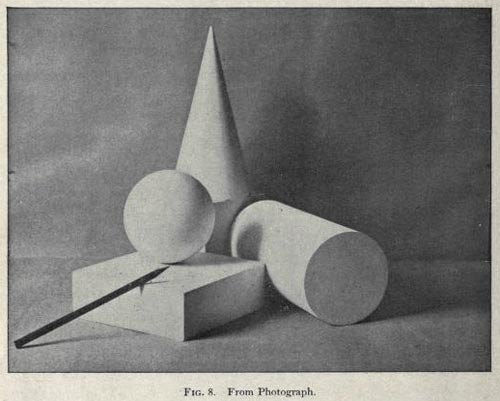
Light at the side. Fig. 8 represents a group of white drawing models placed in a studio upon a shelf and against a background covered with dark gray cartridge paper, the light coming from above at the left and slightly behind the spectator. The effects of light and shade upon the different objects are such as have been described, but owing to the imperfections of the photograph and its reproduction, the gradations in the masses of light upon the different objects are not well expressed. Thus the left-hand contour of the cone should be darker than any element between it and the glitter element. This element does not appear, but should be about as far from the left contour as the ' shadow element is from the right contour ; and the shade upon the sphere should gradually increase in strength from the high light toward the contour in all directions ; and that upon the cylinder should increase from the lightest element, which is about midway between the contour elements, toward the contour elements in both directions. The figure does not show that one of the lights of the group is lighter than all the others, and one of the darks is darker than all others, but it does give the effect of the principal masses of light and dark which it should be the Artists' aim of the student to obtain. Cast shadows show forms of objects.— The cast shadows of the plinth, the sphere, and the cube upon the cylinder show the form of the cylinder and also the forms of the different objects casting the shadows. The shadow of the pencil upon the vertical side of the. plinth extends very faintly towards the shadow of the pencil upon the foreground, for the rays of light causing the shadow cross each other as explained on page if, so that the shadow is dark only very near the pencil. Narrow shadows must be represented. — The plinth does not rest evenly upon the shelf, so that we see under it slightly at the central part of the light side, and a narrow shadow is produced. This shadow is lightened by diffused light from the strong light rays sent to the eye from the surrounding parts, but it is an important detail and should be represented and the advice which is given on page 99 to avoid outlines does not refer to such a place as this where the effect of an outline is given by a narrow shadow or by a narrow edge which catches the light. Studio lights give soft shadows. — The cast shadow of the cone on the background illustrates the fact that with a studio light the crossing rays from a large window so soften the shadows that often they do not suggest the forms of the objects which cast them. Foreground lighter than background. — The mass of the light of the foreground is lighter than that of the background, and illustrates the usual effect of the values when foreground and background are of the same material and color. The foreground is lighter because it generally reflects more light to the eye, and also because it collects in a short time dust which lightens its effect, unless the foreground is very light. The value due to dust should be represented, as it can hardly be kept away from a subject to be studied several times. SUNLIGHT AT THE SIDEFig. 9 represents the same group when exposed to the direct rays of the sun from a direction about the same as that of the light in Fig. 8. Effects are light. — The first point to be noticed is that the effect is much lighter than that of Fig. 8. This is due to the fact that outdoors there are strong reflected lights coming from all directions which lighten all shadows and cast shadows to a great extent. 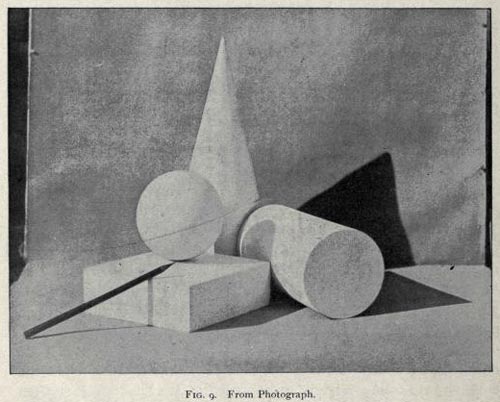
Cast shadows are sharp. — Next we notice that the cast shadows are as sharp and distinct as the edges of the objects. This is always the case when the cast shadows are near the objects that cast them. On the other hand, the greater the distance between any edge and its shadow, the softer is the contour of the shadow, because the rays of sunlight are not quite parallel, and thus soften the cast shadows which are distant. Gradation in shadows and cast shadows. — The cast shadows are sharp in outline and more nearly of one value than in Fig. 8, but there is gradation in them and also in the shadows. Thus the cast shadow of the plinth upon the cylinder reflects dark upon the shadow side of the plinth and upon the cast shadow of the plinth on the foreground. The shadow side of the plinth has nearly the same value as the foreground, instead of being darker as in Fig. 8. Directions of cast shadows. — The cast shadow of the pencil is a continuous band which runs along the shelf, then up on the vertical side of the plinth, and then along upon the top of the plinth, where its direction is the same as upon the shelf, for when the shadow of any line falls upon parallel sulfates the shadow has the same direction on each surface. The cast shadow of the pencil upon the shelf and of the cone upon the backgroUnd are curved by the uneven surface of the paper. A STUDIO LIGHT BEHIND THE SPECTATOREffect is a mass of light. — Fig. 10 represents the same group placed in a studio and lighted by a window directly behind the spectator. This light causes the visible surfaces of the objects to be light surfaces and the effect of the whole group to be that of a mass of light, for the cast shadows are behind the group and are largely invisible. The objects are distinguished from each other by slight differences in value, and the gradations of tone upon any one are very delicate. The cone, cylinder, and sphere each have a glitter point or line. These lights are upon the nearest parts of all the solids, and from them there is a tone which gradually increases in strength towards the contours. The plinth also has a part which is lighter than any other part of its surface ; but high lights are seldom found upon polyhedrons, even when their surfaces are polished, for in order to glitter a plane surface must as a whole reflect the light directly towards the eye. Little contrast of light with shadow. — The visible cast shadows are small in Fig. 1o, and are always small when the light is behind the spectator, unless they are cast by parts which overhang and cause cast shadows to fall upon the visible light surfaces. There is also seldom the contrast of a light surface with a shadow surface, and therefore in general very little contrast of light and dark. Effects too difficult for students. — This position of the light is not suitable for students. It requires the ability of an artist to represent solidity and atmosphere by the delicate gradations given by a light behind the artist, no matter whether the light be that of a studio, sunlight, or any other light. 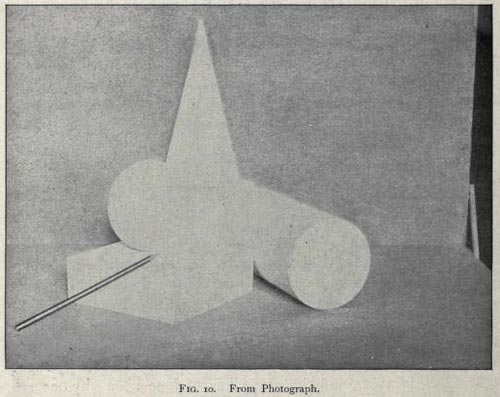
Contrasts are largely due to color. - The principal contrasts of light and dark with this light are generally due more to contrasts of local color than to contrasts of light and shade. Objects reflect strongly in the foreground. — The reflected light from the end of the cylinder to the foreground is so strong that even on the rough paper it gives a clear reflection of the edge of the cylinder. The cast shadow of the camera fell upon the foreground and darkened it ; were it not for this shadow, the nearest part of the foreground would be the lightest. A STUDIO LIGHT IN FRONT OF THE SPECTATOREffect largely shadow. — Fig. 11 represents the group when placed in front of a studio window. This position causes the visible surfaces to be largely shadow surfaces. 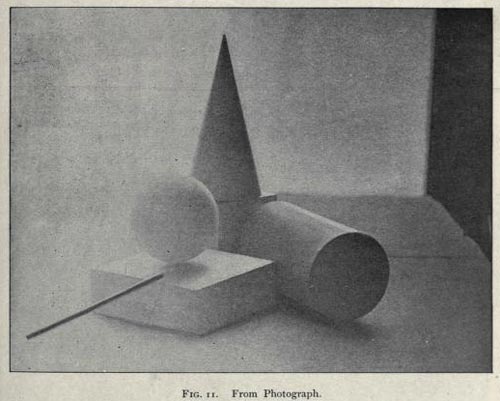
The cast shadows are dark and prominent in the effect, as they are,wholly visible and extend toward the spectator. Fig. 11 in contrast with Fig. 1o, presents a mass of dark which is the general effect indoors or outdoors when the light is behind the objects ; it also shows that the shadow surfaces with the cast shadows form the larger part of the subject. Strongest shadows on the nearest parts. — The increase in the strength of the shadow upon the cone towards its vertex is well shown, and also the fact that the strongest darks are generally on the parts nearest the eye. Strongest lights on the contours. — The strongest lights are on or near the contours of the objects. On the pencil the glitter light at the contour, and makes the black pencil lighter than the light arts behind it. DIFFUSED STUDIO LIGHT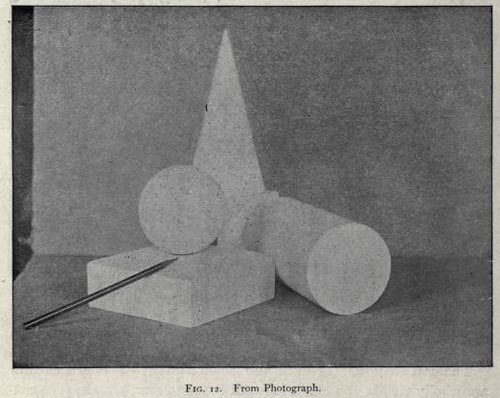
Fig. 12 represents the same group when it is lighted by weak diffused light coming from both sides and from behind the spectator, and producing about the same effect as would he obtained in a room having several windows whose curtains are drawn. Delicate light and shade contrasts. —We find there are several faint, soft shadows and no strong contrasts. In this respect the effect is similar to that of Fig. 10, but very much darker, — a fact not well shown by the figure. Dark objects may have strong lights. — The glitter light upon the pencil is prominent, and well illustrates the fact that even the darkest objects whose surfaces are polished may have upon them the strongest lights of the group. ARTIFICIAL LIGHT AT THE SIDEFig. 13 represents the same group when exposed to the rays of a very powerful lamp placed near the group. 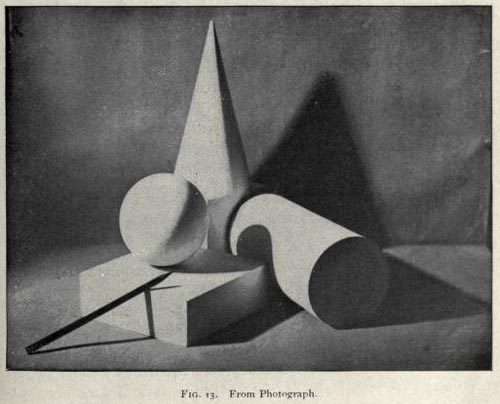
Strong contrasts of light and shade. — The effect is due to the contrast of strong lights and deep shadows, and at first glance we feel the simplicity of the masses of light and shadow. Fig. 13 makes these masses more simple than they really were, for it does not give the delicate gradations. The light and dark upon the cone, for instance, would, except near its base, represent a pyramid ; for there is so little gradation near the shadow element that the idea of roundness is not well expressed. Upon the sphere the circle (ellipse) that separates light from shadow is also very sharp. Sharp and dark shadows. — Sharpness is, however, a distinguishing feature of the shadows of objects that are exposed to one strong artificial light, and the stronger the _light, the greater the contrast between the masses of light and shadow, and the less the gradation from one to the other upon rounded objects. There is, of course, gradation upon rounded objects, but it is very delicate through all the mass of the light, and is principally confined to a very small space near the shadow element. Masses of dark very simple. — Another effect characteristic of a single artificial light is the strength and simplicity of the masses of shadow formed by the shadows and cast shadows. The base of the cylinder and the cast shadow of the cylinder illustrate a common effect, namely, that in which the shadow and cast shadow adjoining are nearly of the same value. The shadow side of the cube illustrates another effect, that in which the shadow and cast shadow are of the same, or so nearly the same, value that the contour of the object is lost in the mass of shadow. The student who works with light and dark or with color should be careful not to represent contours which cannot be seen, for much of the interest and artistic effect of the drawing depends upon its being true to nature in this respect. MOONLIGHTSimple masses. — The given illustrations cover the most common effects with the exception of those due to moonlight. Moonlight is simply weakened sunlight; and produces effects similar to those of sunlight in respect to the contrast of simple masses of light and dark and the sharpness of the cast shadows.- The principal mass of light and dark are much more prominent than by sunlight, and few details are seen in the masses. The masses of dark are especially simple, for reflected lights are very weak, and often not noticeable. LIGHT FROM SEVERAL SOURCESShown by cast shadows principally. — The effects due to the light of a room and to artificial light may be, and generally are, greatly varied by the crossing of light from several sources. The principal effect of several lights is seen in the cast shadows, where the cast shadow due to any light may be followed just as if it were the only cast shadow. Any one cast shadow is darkened where a second shadow falls upon it ; but the contour of the second may be seen as distinctly as that of the first, and any number of cast shadows caused by different lights may be clearly seen, the strongest part of the cast shadow being the part which receives the greatest number of different cast shadows, and being central and nearest the object. LIGHT AND SHADE EFFECTS UPON OBJECTS OF DIFFERENT COLORSHaving compared the principal effects of light and shade, and also those due to different lights upon the same subject, we will study in detail the effects of light and shade upon objects of different colors, beginning with the high light and ending with the cast shadow. THE HIGH LIGHTIs influenced by smoothness of surface. — The strength of the high light depends upon that of the illuminating light, and upOn the smoothness of the surface which reflects it ; the smoother the surface the brighter the high light, and the more perfectly it reflects the color of the illuminating light. A polished metal vase or any glazed object will give a perfect image of the source of the light. In a studio, for instance, it will reflect the window with its crossbars, and the color of the high light will be that of the sky or whatever else sends the light through the window to the object. 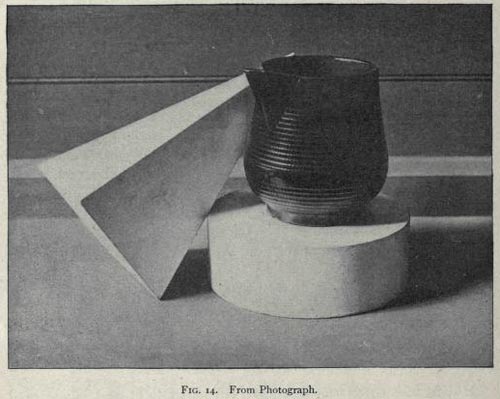
Is colored. —Pupils are generally so deceived by the brightness of high lights, especially those on dark glazed objects, that they fail to see any color in them, and represent them by pure white, even when they have a white object in the group. They should remember that such lights always reflect the color of the light causing them, and are darkened by the color of the object on which the light falls.. If they will try the experiment of blurring the form out of any high light by holding the blur glass as far from them as possible, still obtaining in it the image of the high light, they will readily see the color blue in case the object reflects the blue sky. This experiment shows that the high light upon a glazed object may be darker than that upon a white object, even if unglazed. 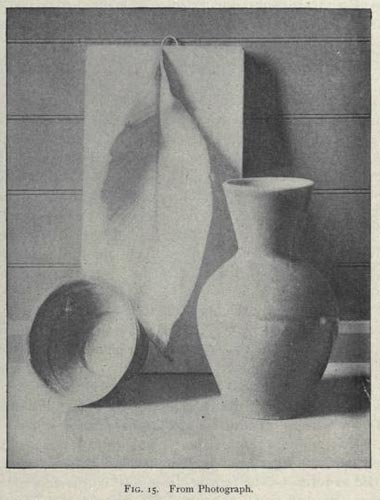
Varies upon different colors. — Every object reflects directly some white light. The remainder of the white light enters the object a little distance where some is absorbed, and the remainder is turned back and reflected in all directions, the reflected rays having the same color as the object. Now a dark object reflects less of the light which enters its surface than a light object, and hence the. high lights upon polished objects of different colors are not equally light when the surfaces are equally smooth. By contrast the highlight upon a dark glazed object may appear lighter than that upon a light and equally glazed object, but it is really not as light. Local color not seen in high light. — The local colors of objects are not seen in the high lights, even when the objects are not polished ; for when the high lights do not reflect the color of the light, they are so heightened by the strong light they receive that they do not give the effect of the local color of the object ; and as a matter of fact the high lights upon the human face are often cool and even bluish in tone. Generally caused by rounded surfaces. — Glazed objects which are round or bounded by curved surfaces will generally have high lights in any position of the spectator. A plane surface which glitters throughout must be very small. When an object bounded by plane surfaces is so placed that one surface glitters, the slightest change in the position of the eye may entirely change the effect ; for a surface which glitters with the eye in one position will not glitter if the eye is moved a short distance, and instead of appearing the highest light, it may appear dark if its local color is dark. Varied in form. — The form of the glitter light is dependent upon that of the window or other source of light, and also upon that of the object. Upon a curved surface straight lines generally reflect as curved, and upon a plane surface they reflect as straight. Iridescent color. — The most beautiful color effects are found in the high lights upon iridescent objects, and the study of these lights will assist the student to realize how changeable are the colors and the values of the same object. Must be carefully drawn. — The effect of a glazed object can be given only by carefully drawing the high lights upon it, and they must be represented with decision,1 for when gradually softened into the mass of light, the effect of an unglazed object is given. 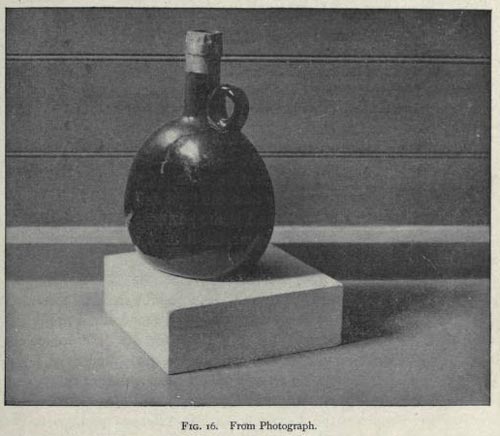
Found upon every rounded part. — A high light is found upon every polished surface whose position is such that it reflects the light directly into the eyes. In Fig. 16 there are two lights upon the body of the bottle, because there were two divisions in the window from which the light came. Fig. 14 shows how high lights are 'found upon the edges of objects, and upon all ridges or mouldings. Figs. i 5, 17, and 18 show that these high lights are found in relatively the same position upon the different curved parts of the same object, so that they may be said to exist on a single element of the surface. In the cone and cylinder the element is straight, but in the bottle or vase the corresponding line or element is curved, and may be regarded as the outline of a section of the object made by a plane passing through the axis ; it is foreshortened so that, in Fig. 18, for instance, if the light were directly behind the spectator, the different high lights upon the vase would come in one vertical line, — the center line of the vase. PREVIOUS PAGE
|
||||||||||||||||
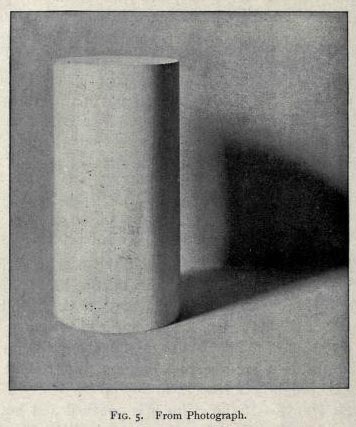 Gradation in the light. — With a studio light the gradation from light to dark is more gradual, and from the high light we find a gradually increasing tone which increases in strength near the shadow element and gradually becomes shadow. We find also in any light, gradation. from the glitter element in opposite directions, so that at the contour element in the light the tone is darker than at any element between the contour and the glitter element. The drawing imperfectly represents this gradation in which there is no sudden change from one element to the next.
Gradation in the light. — With a studio light the gradation from light to dark is more gradual, and from the high light we find a gradually increasing tone which increases in strength near the shadow element and gradually becomes shadow. We find also in any light, gradation. from the glitter element in opposite directions, so that at the contour element in the light the tone is darker than at any element between the contour and the glitter element. The drawing imperfectly represents this gradation in which there is no sudden change from one element to the next.







